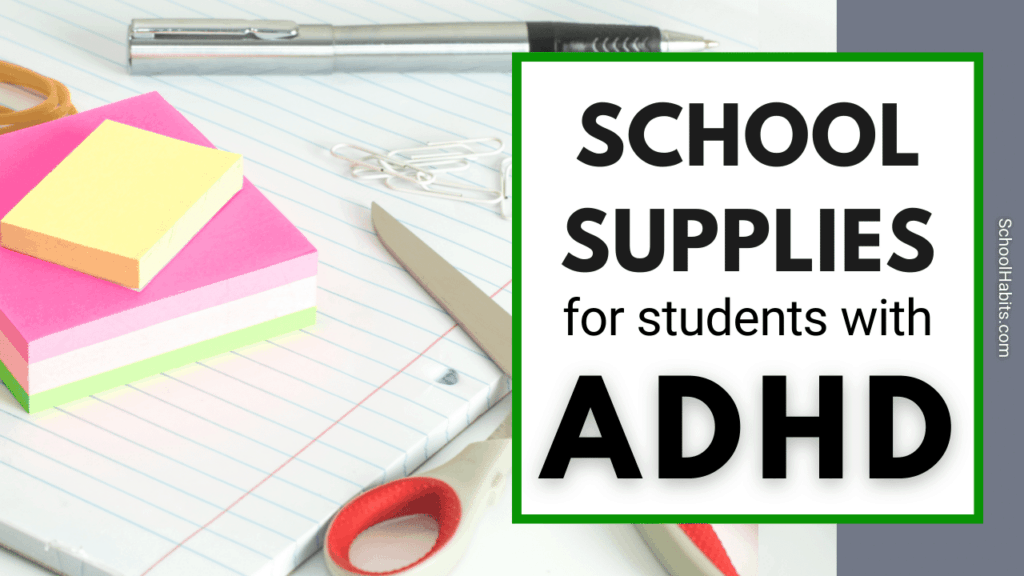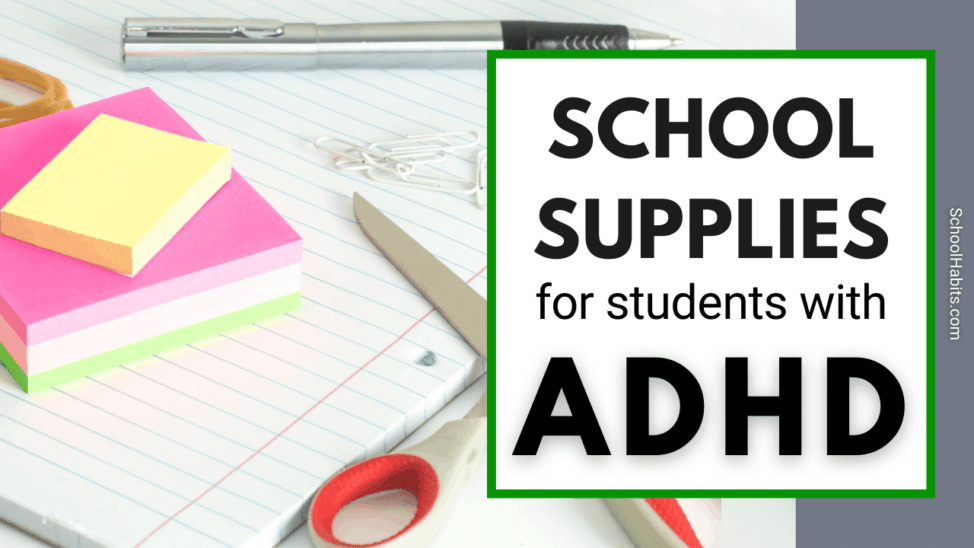By Katie Azevedo, M.Ed.

School supplies for students with ADHD may look a little different than school supplies for neurotypical students. Neurotypical students often choose school supplies based on factors like aesthetics (does it look cool), popularity (is it actually cool) and teacher requirements (the teacher requested it).
But students with ADHD should choose school supplies based on a different set of factors. I will elaborate on each factor throughout the post, but here they are at a glance:
- Function
- Simplicity
- Personal preference
Function: Students with ADHD should choose school supplies primarily for function. Function refers to the purpose of the item and how it helps the student. If the item is cool and “everyone has one,” but it doesn’t serve a very specific need, it’s unnecessary. Soon enough that item will end up lost or at the bottom of a backpack. Before purchasing any school supplies item, ask this question: what is the exact purpose of this?
Simplicity: School supplies for students with ADHD should be as simple as possible, with the bare minimum features. No zippers, difficult snaps or clasps, or pockets within pockets. Try to find supplies that offer just one touch-point in order to reduce friction.
Personal Preference: Students with ADHD often have unique preferences for things (this characteristic is awesome!), and those preferences should be honored when choosing school supplies. Does the student like a particular shade of blue, even though that color is hard to find? Find it. Does the student like blue gel pens over ball-point pens? Buy the blue gel pens.
School supplies suggestions with ADHD in mind
The following suggestions are geared towards students with ADHD because they help reduce confusion, friction and disorganization.
1. Choose wide-ruled paper over college-ruled paper.
People with ADHD often have larger handwriting than do people without ADHD. Wide-ruled notebook paper accommodates larger penmanship and is available as loose-leaf sheets or in a bound notebook. Wide-ruled paper also provides more white space on the page; sufficient white space is helpful in reducing visual distractions and signaling to the eye where it should focus. (Struggle with your handwriting? Try this one simple tip.)
You might also consider using graph paper, as many students with ADHD find the extra vertical guidelines helpful.
2. Consider an all-in-one binder system.
Instead of using a separate notebook and folder for each subject, try using one large 3-ring binder that holds all the subjects together. With an all-in-one binder system like this, you can still separate each subject with dividers, and each subject can still have its own folder (use folders with 3-holes in them, or punch your own).
Sure, the binder may end up being massive, but as long as the student brings home that one binder, he or she will be guaranteed not to forget anything at school – or vice versa.
When picking a binder, keep it as simple as possible: no zippers, velcro, or doohickies. The binder should be accessible (openable) with one motion and one hand.
Here is my complete guide on how to set up and organize a school binder. It’s loaded with tips for students with ADHD.
3. Use color-coding.
When choosing folders, notebooks, and dividers, choose one color per subject in order to capitalize on the power of color association. The student should choose colors based on their personal preferences.
4. Label all school supplies with the student’s name.
This suggestion may sound elementary (if the child is in elementary school, then that’s all good) – but I assure you it can be a powerful strategy for high school and college students as well. Psychologically, we respond more acutely to our name than we do to inanimate objects; therefore, a student with ADHD is less likely to lose, forget or overlook school supplies with his or her name on them.
5. Use a catch-all folder.
Organization and split decision-making are challenging for students with ADHD. The use of a catch-all folder (in an all-in-one binder) can reduce the anxiety that comes with determining where to put papers when time is tight (at the end of class, when the teacher is quickly moving on to another topic, etc.). Someone with ADHD may struggle to identify that their math packet needs to go in their math folder, so instead of opting for their default option (throw the paper into the bag to disappear forever!), they can put the paper into their catch-all folder.
The caveat is that the catch-all folder has the potential to become a hazard area and should be processed at least twice a week. Similar to a catch-all folder, a Limbo Folder could also be a good option.
6. Tie a writing utensil to their all-in-one binder.
ADHD and lost writing utensils go together like … all the things that go together. The thing is that if a student with ADHD can’t find a pencil in time, he or she is more likely to entirely avoid writing down what needs to be written down. An easy solution is to tie a pen or pencil to the all-in-one binder (and definitely to their assignment notebook!) in order to reduce friction points.
If you have a student or are a student with ADHD, choosing the right school supplies can make all the difference in the world. And don’t forget that you can make adjustments as you figure out what works and what doesn’t; if something about your current system isn’t working for you, figure out why and then make a change. If your backpack is a total disaster, here are 4 backpack organization tips.
If you have ADHD (or if your child does), they likely have executive function deficits. After 16 years of working with students with ADHD, I have created the Executive Function Journal – a 90-day journal that targets and builds key executive functions. It’s simple and it works, and you can learn more here.
More resources about choosing school supplies
Here’s my complete guide about choosing school supplies based on your learning style.

